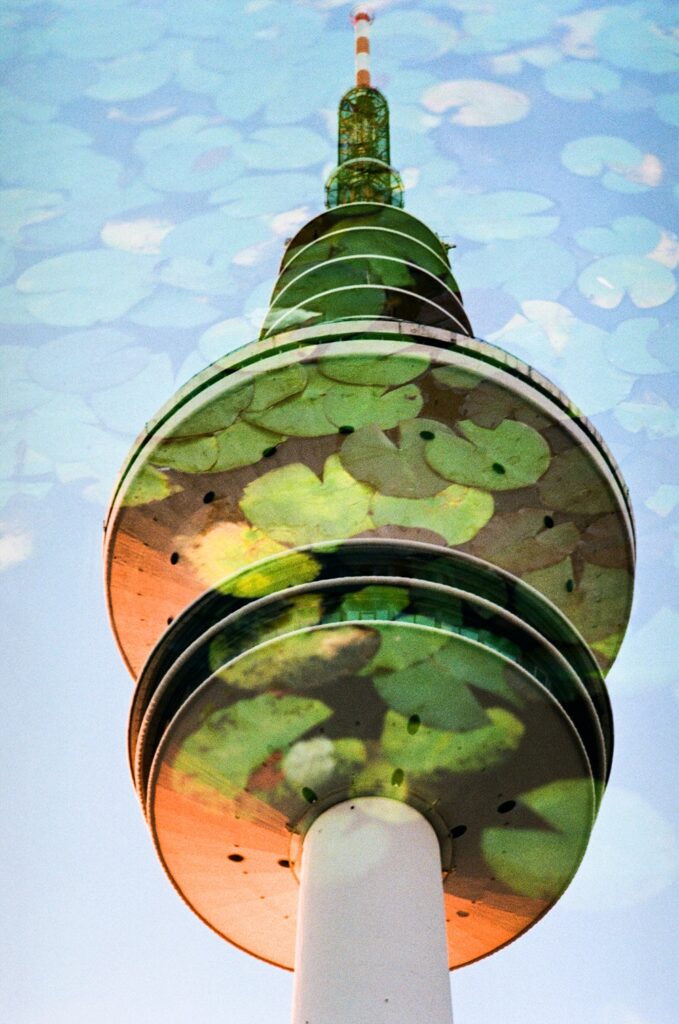Welches Motiv hast Du hier zuerst fotografiert?
(English version of the text at the end of the page)
Diese Frage, und ob das Einfluss auf das Ergebnis der Überlagerung bei der Doppelbelichtung hat, kommt sehr regelmäßig, wenn ich mich mit Leuten über Doppelbelichtungen unterhalte. Meistens muss ich dann antworten, dass ich die Reihenfolge nicht mehr weiß und dass ich dies persönlich auch nicht als relevant für das Ergebnis halte, es sind vielmehr die Lichterverhältnisse.
Damit wirken die Fragenden eigentlich recht zufrieden, bei mir bleibt aber manchmal doch ein kleines Fragezeichen zurück. Wenn diese Frage doch so viele Leute beschäftigt, warum nicht einfach mal ein paar Beispielbilder machen?
Also habe ich bei meinen letzten Rollen Film immer mal wieder ein Motiv zweimal hintereinander doppelbelichtet, jeweils in anderer Reihenfolge und bin dafür auch mal mehrfach zwischen zwei Motiven hin und her gerannt, um diese Frage systematischer zu klären.


Hier habe ich beispielsweise im ersten Bild erst den Fernsehturm und dann die Seerosen und im zweiten Bild erst die Seerosen, dann den Fernsehturm fotografiert. Wie man sehen kann, gibt es kaum einen Unterschied zwischen der Überlagerung der beiden Motive.
Das Gleiche habe ich bei der folgenden Kombi aus Boots und Äpfeln gemacht:


Man sieht es auch gut bei der Überlagerung dieser beider Dahlien: die eine Blüte ist weiß, die andere pink – egal, welche Blüte man zuerst fotografiert, die hellere dominiert und wird auf dem dunkleren Hintergrund sichtbarer.


Dass die Reihenfolge egal ist, sieht man ja auch an den 180 Grad gedrehten Belichtungen: Hier sind beide Motive exakt gleich gut zu sehen, obwohl eines der Beiden zuerst aufgenommen werden muss.


Was aber tatsächlich einen Einfluss hat, sind die Belichtung und die Lichtverhältnisse des gewählten Motivs. Weiter unten habe ich eine Szene aus St. Andrews in Schottland zweimal doppelbelichtet: Im ersten Bild ist die Wiese mit den Gänseblümchen im Sonnenschein gewesen, also heller und so sieht man mehr Grasstruktur auf den dunklen Felsen. Beim zweiten Bild hatte ich einen Abschnitt der Wiese im Schatten gewählt. Hier sieht man weniger von der Wiese, sondern eher nur die hellen Gänseblümchen.


Fazit: Für mich ist es echt egal, welches Motiv zuerst auf dem Film ist, viel interessanter ist es, mit der Belichtung und der Verteilung von hellen und dunklen Flächen auf den beiden Motiven zu variieren und sich immer mal überraschen zu lassen, das ist ja gerade auch das Schöne an der Doppelbelichtung.
Schreib mir gerne, wenn Du auch Tipps hast zum Thema Doppelbelichtung. Und check gerne einen meiner ersten Blogbeiträge zum Thema Doppelbelichtung: hier.
English Version: Which subject did you photograph first?
This question comes up very regularly when I talk to people about double exposures. I usually have to answer that I can’t remember and that I personally don’t think it’s relevant for the result, it’s more a question of the lighting conditions.
The questioners actually seem quite satisfied with this, but I am sometimes left with a small doubt. If so many people are asking this question, why not just take a few sample pictures?
So with my last few rolls of film, I always double-exposed a subject twice in a row, each time in a different order, and I also ran back and forth between two subjects several times to clarify this question more systematically.
In the case of the two pictures of the television tower for example, I first photographed the television tower and then the water lilies and then the other way round in the second picture. As you can see, there is hardly any difference between the combination of the two motifs.
I did the same with the combination of boots and apples.
You can also see it well in the composition of two dahlias: one flower is white, the other pink – no matter which flower you photograph first, the lighter-coloured one dominates and becomes more visible on the darker background.
The 180-degree rotated exposures also show, that the order doesn’t matter: Here, both subjects can be seen exactly equally well, although one of the two has to be taken first.
What actually has an influence, however, is the exposure and the lighting conditions of the chosen subject. I have double-exposed a scene from St Andrews in Scotland: In the first image, the meadow with the daisies was in sunshine, so it was brighter and you can see more grass structure on the dark rocks. In the second picture, I chose a section of the meadow in the shade. Here you can see less of the meadow, but rather just the light-coloured daisies.
Conclusion: For me, it really doesn’t matter which motif is on the film first, it’s much more interesting to vary the exposure and the distribution of light and dark areas on the two motifs and to always be open for surprises, which is the beauty of double exposure.
Feel free to write to me if you have any tips on the subject of double exposure. And feel free to check out one of my first blog posts on the subject of double exposure: here.